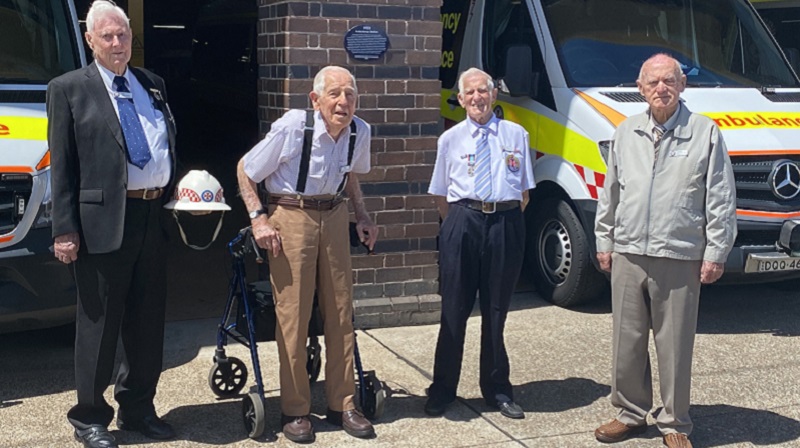Our Legacy Spotlight Series shines a light on and supports NSW Ambulance Legacy members tell stories from their time as paramedics and clinicians.

Once a month, four snowy haired gentlemen dressed in their best clothes – smart pants and shirts, usually all with ties and one wearing braces, catch up for lunch at a local Newcastle club.
They might be slow on their feet at times but Fred Caban, Clarrie Boekenstein, Norman Masters and Harry Pallister are lively with their conversation. As nonagenarians, all aged 90, they have a remarkable friendship spanning over 70 years.
The retired NSW Ambulance Officers are members of the Hunter Legacy group which has met monthly for 30 years. It’s mateship at its finest with members sharing a meal to stay socially connected, talking about old jobs and all things Ambulance.
These four, known as the Over 90’s Club, have a combined 125 years of service and recently visited Hamilton Ambulance Station, where each of them worked at some point during their career.
“I wish I had a penny for every time I swept out this Plant Room,” Clarrie declared as he looked around at all the new equipment. A late starter as an Ambulance Officer, Clarrie joined as a 41-year-old after working for 25 years at the the Newcastle and District Co-operative Society before resigning in 1971.
“To gain permanent paid employment then, you had to be lucky or come recommended by a friend,” said Fred Caban who was Station Officer at Newcastle.
“You had to ask the bosses to give your mate a go.” And that’s exactly what Fred did when Clarrie was put on permanently. The two enjoyed long careers, both retiring in the mid-1990s.
Monica Arnold, an Extended Care Paramedic at Hamilton, has been in the job 35 years and recognised Clarrie during the visit as the man who looked after her during her very first shift as a paramedic.
“I would have been here just before you left and I worked with you at Birmingham,” she declared.
“The first patient we had was a vomiter and I couldn’t find a vomit bowl as it was known back then.”
“That’s right,” Clarrie nodded with a wide, warm smile.
“We used to make do with what we had and it was either the patient’s top or a hard hat if we couldn’t find the bowl. I always check now that the first thing I have got is the vomit bag,” Monica said.
Clarrie laughed: “Oh, well you learnt something then.”
Relaxing in the leather recliners in front of a series of historic photos in the station’s History Room, the men chatted for more than an hour and sometimes the emotion of those times could be seen in their misty eyes when some recollections brought back good memories.
Harry smiled when talking of joining, saying it was the people he met while studying three years of First Aid classes that made the difference.
“Quite a few of the Ambulance Officers were ex-servicemen and they moved into the Ambulance Service after the war ended in ’45,” he said. “They were top blokes, really quality people and you had to be invited in then.”
Fred agreed the workplace friendship was very important.
“We became one big family,” he said. “If somebody had concreting to do, anyone on afternoon shift or off would come to help. We helped each other a lot and it was a really, close family.”
And that’s the reason they all still keep in touch. “Meeting up is for the fellowship,” he said.
Another thing they share is a great admiration for the skills of today’s paramedics.
“They are far superior to our skills and there is no comparison,” he declared, with Fred agreeing.
“Far superior in saving lives but they have drugs and equipment which we didn’t have,” Fred said.
Norm said his appointment to Superintendent at Albury Ambulance Station was a career highlight, giving him managing experience with the staff of 10 towns along the Murray River.
“They were bonza people and I enjoyed meeting them on inspections once a month and being part of their family every time I visited a station,” he said. “And it was a most enjoyable time even though they paid me.”
Harry, who worked as a Dispatcher in the Sydney Coordination Centre, was known as the additional officer there because he would add an additional patient for transport on most shifts rather than making them wait for someone to come back to get them.
“It really mattered if you attended to their transport because there was a lot of people on day treatment and we could handle five or six people in a car. A car might be leaving with four on and you’d have to say, ‘I’ve got an additional for you.’ ”
Norm praised Harry’s work ethic saying: “He was a good operator and I enjoyed working with Harry as I was always confident he was doing the right thing.”
As the visit drew to a close, Paramedic Dean Wales thanked the group for stopping by the station.
“It’s always great to talk to the people who have come before us in this profession,” he said.
NSW Ambulance Legacy provides an inclusive and supportive network and services for former employees who become members. Click here to find out more.
This story appears in the January 2021 edition of NSW Ambulance's internal magazine, Sirens.
